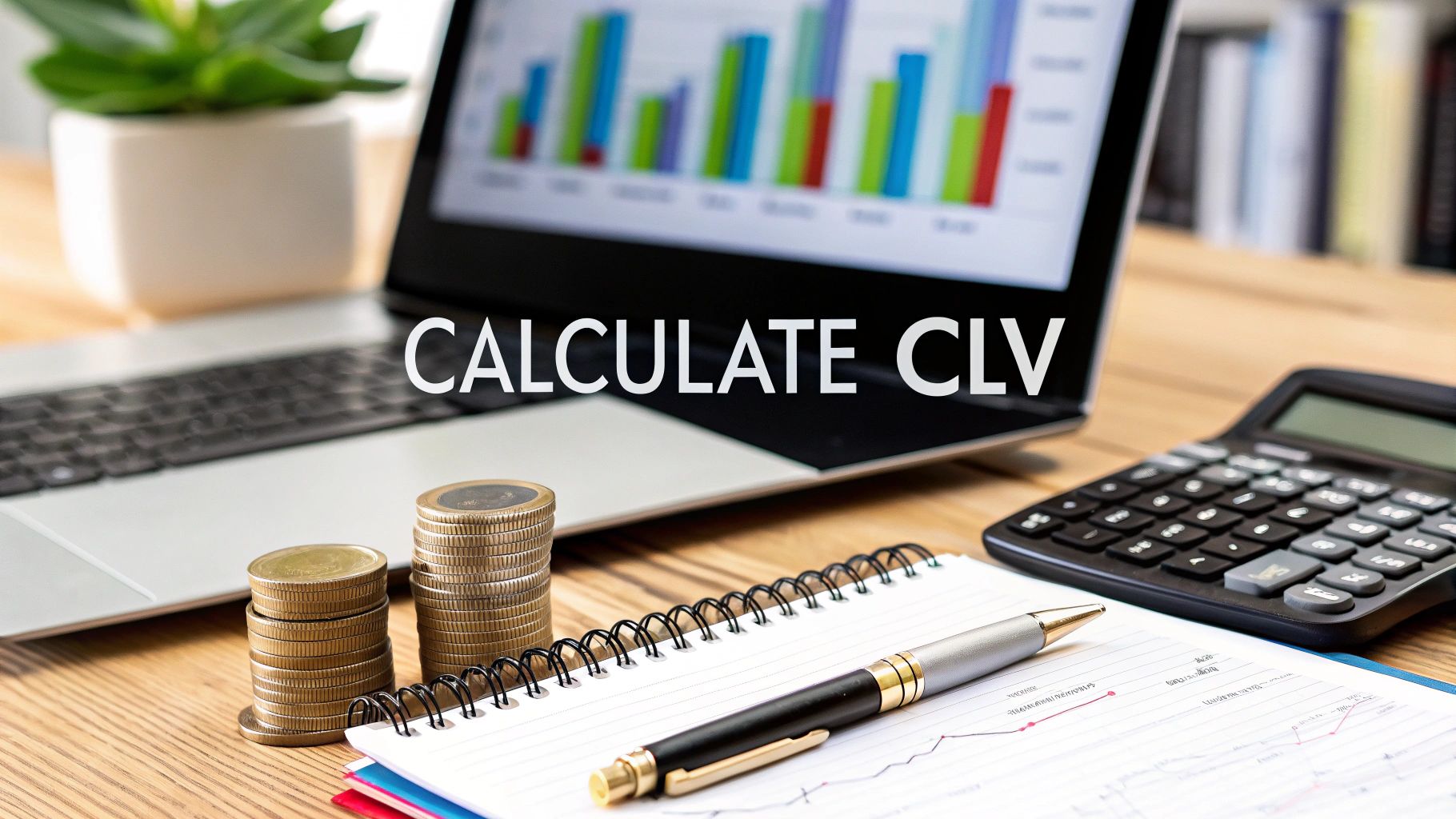Forget chasing expensive, one-time sales. As an e-commerce brand, you know the real, sustainable growth comes from the customers who keep coming back. But how do you measure that loyalty? This is where Customer Lifetime Value (CLV) becomes your guiding light—it’s the total profit you can realistically expect from a single customer over their entire journey with your brand.
In this guide, you'll learn exactly how to calculate customer lifetime value, why it’s a game-changer for your business, and how to use a tool like WhatsApp to actively increase it.
Why CLV Is Your Most Important Growth Metric
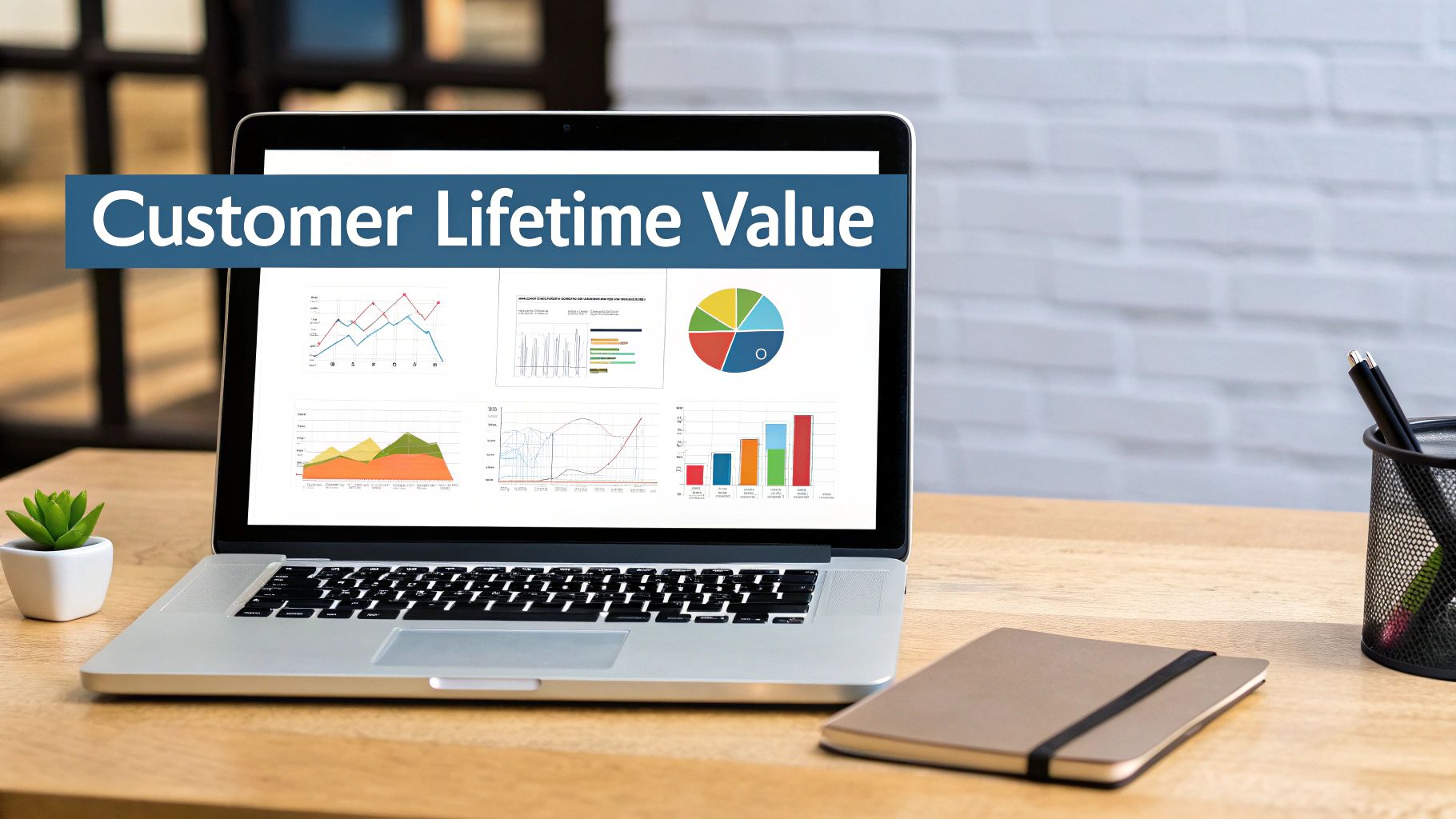
From our experience with over 500 Shopify stores, we've seen a clear pattern. The brands that are obsessed with CLV consistently outgrow those that only hunt for new customers. When you shift your focus to CLV, you move away from expensive acquisition cycles and start building profitable, long-term relationships. It’s a complete game-changer.
A high CLV is a direct signal of a healthy business. It proves that your products, marketing, and customer service are all working in harmony to create genuine fans, not just one-off buyers. Think about it: acquiring a new customer is a costly gamble, but convincing an existing one to make another purchase is far more profitable.
A common mistake we see: Brands pour their entire budget into top-of-funnel ads while sitting on a goldmine—their existing customer list. Your best customers are your biggest asset, period.
The numbers don't lie. Research from sources like Shopify shows that improving customer retention by just 5% can increase profitability by over 25%. That classic 80/20 rule often holds true here; a small group of your loyal customers (around 20%) is likely driving the majority of your revenue (around 80%).
Despite this, only about 42% of companies can actually measure their CLV with any accuracy, even though nearly 90% agree it’s a critical metric. You can find more eye-opening CLV statistics that highlight this gap.
Stop Thinking in Transactions and Start Thinking in Lifecycles
Once you get a handle on CLV, you unlock smarter, more strategic decisions across your entire business. Suddenly, you're able to:
- Fine-Tune Your Ad Spend: You'll know exactly how much you can afford to spend to acquire a new customer. If your average CLV is $300, spending $50 on ads to bring that person in is an obvious win.
- Create Powerful Retention Campaigns: You can pinpoint your most valuable customers and design targeted campaigns just for them. Think exclusive offers or early access, sent directly through a platform like our WhatsApp marketing tool. As an official Meta Business Partner, we help brands leverage WhatsApp for exactly this.
- Guide Product Development: By analyzing which products lead to a higher CLV, you can double down on what your best customers love most.
In this guide, we'll break down exactly how to calculate this metric and start making these kinds of data-backed decisions today.
A Simple Way to Calculate Customer Lifetime Value
Diving into your business metrics doesn't have to be overwhelming. You don’t need a data science degree to figure out your customer lifetime value. In fact, there's a straightforward way to calculate it using just three key pieces of data you probably already have sitting in your e-commerce platform.
Let's get right into the essential components. This infographic breaks down the three core metrics you'll need to pull together to find your CLV.
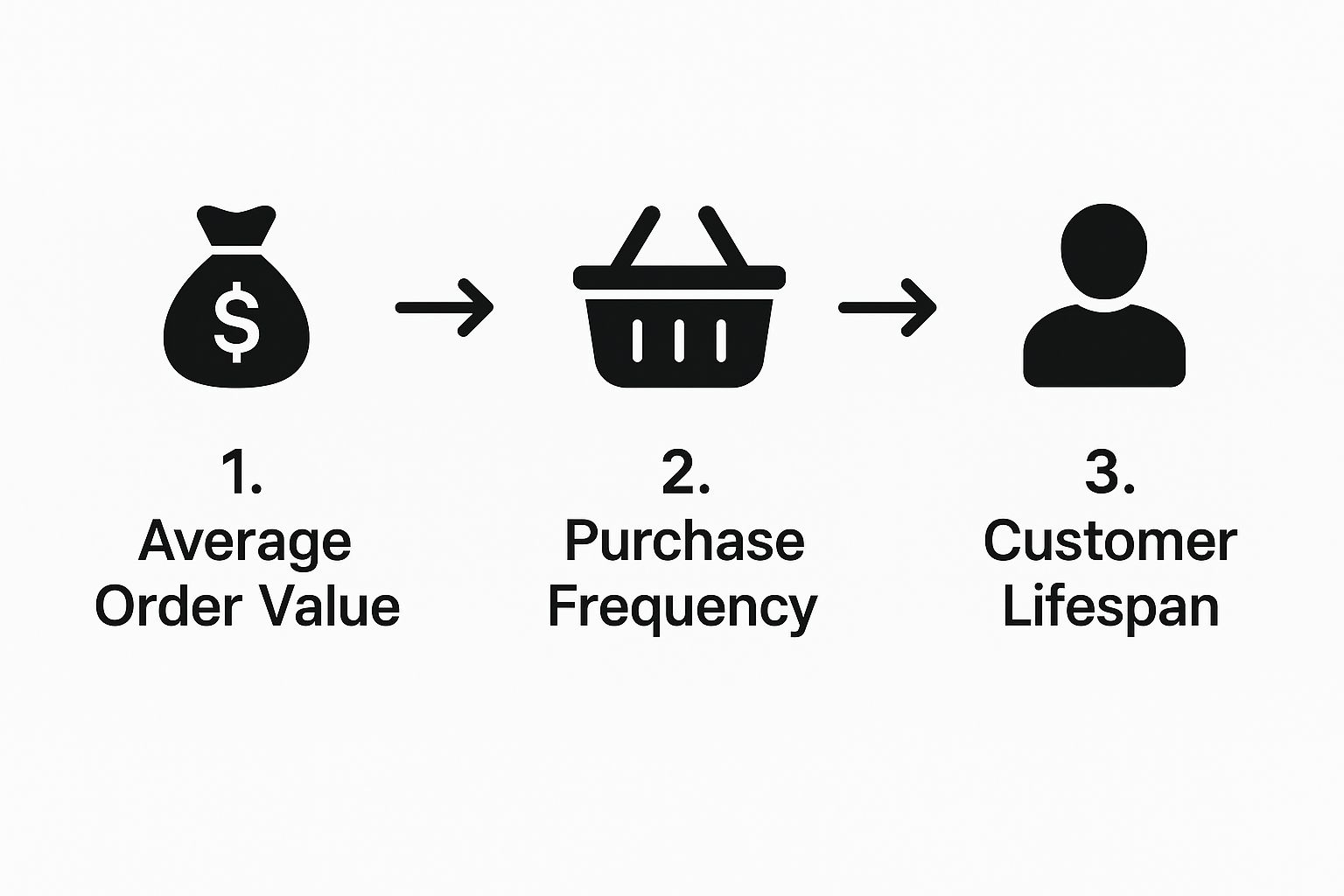
Think of it this way: each metric builds on the last, taking you from simple transaction data to a powerful, long-term business insight.
The Three Core Metrics
To get started, you just need to track down three numbers from your store's analytics.
- Average Purchase Value (APV): First, figure out how much a customer typically spends in a single order. You can calculate this by dividing your total revenue by the total number of orders over a set period, like the last year.
- Purchase Frequency (PF): Next, how often does the average customer come back to buy from you? Find this by dividing the total number of orders by the number of unique customers within that same timeframe.
- Customer Lifespan (CL): Finally, determine the average amount of time a customer stays with your brand. This can feel tricky for newer stores, but a solid starting point is to average the time between a customer's first and last purchase. Most e-commerce platforms have this data in their analytics reports.
With these three numbers in hand, the formula itself is incredibly simple.
The Simple CLV Formula:CLV = Average Purchase Value (APV) x Purchase Frequency (PF) x Customer Lifespan (CL)
Understanding this number is fundamental for sustainable growth. It helps you justify marketing spend, focus your efforts on retention, and navigate the challenge of rising customer acquisition costs.
A Real-World Example
Let's put this into practice with a fictional brand, "Glow Skincare." After digging into our Shopify data for the past 12 months, here's what we've found:
- Our Average Purchase Value is $75.
- Our customers purchase, on average, 4 times per year.
- Our Average Customer Lifespan is 2 years.
Now, we just plug those numbers into our formula:
$75 (APV) x 4 (PF) x 2 (CL) = $600 (CLV)
So, what does this tell us? On average, every new customer we bring in is worth $600 in revenue to Glow Skincare over their entire relationship with us. That single number is a game-changer. It gives us a clear ceiling for how much we can afford to spend to acquire a new customer and still turn a profit.
Want to get this number without crunching the numbers yourself? You can use our free customer lifetime value calculator to get an instant result for your brand. It's a quick way to get the data you need to start making smarter decisions.
Moving Beyond the Basics with Predictive CLV
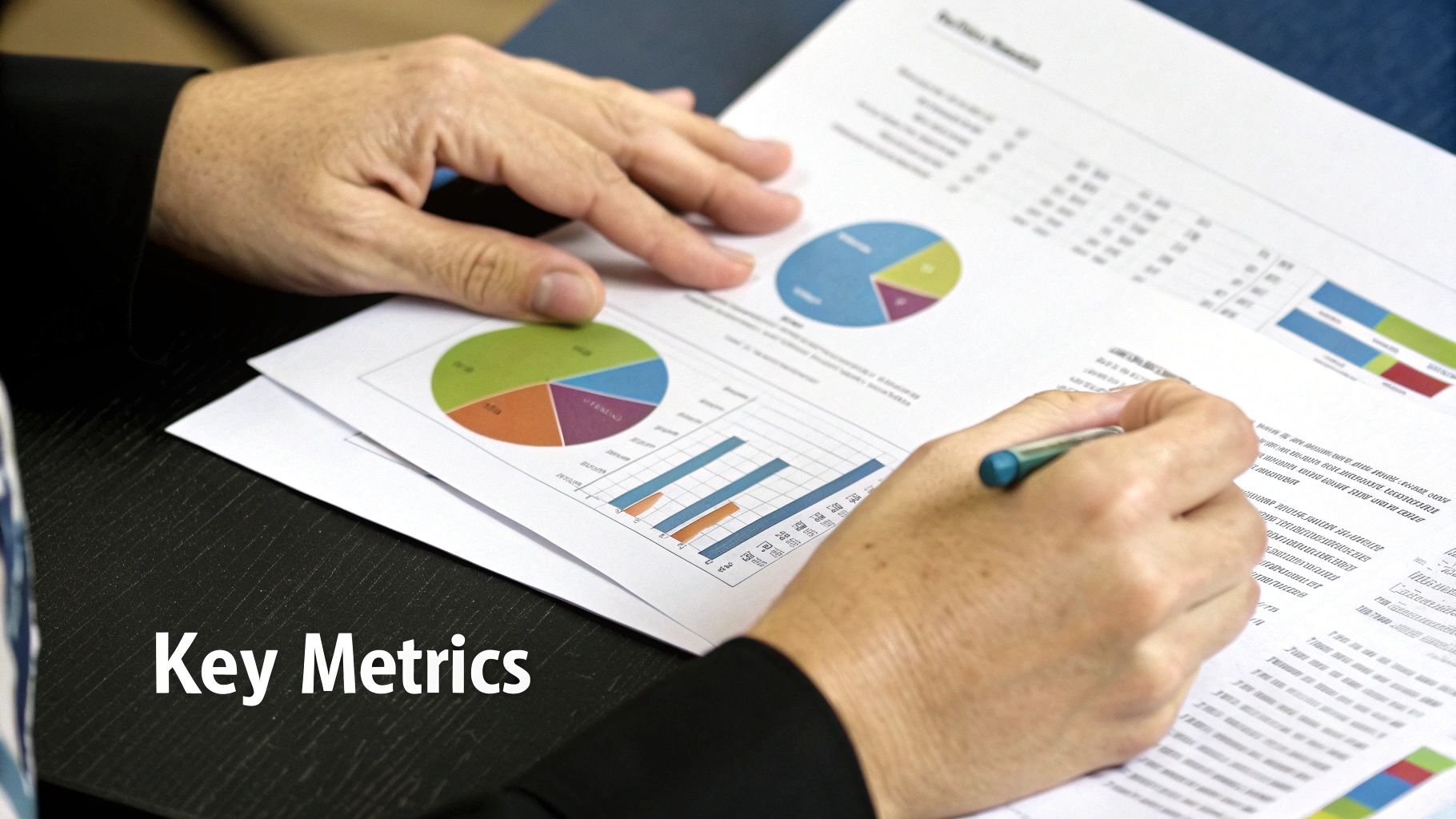
The simple CLV formula is great for a quick look in the rearview mirror. It tells you what your customers were worth based on their past actions. But what if you could predict what they will be worth? That’s where the real magic happens, and it’s the core idea behind predictive CLV.
This isn’t some far-off concept reserved for data scientists at massive corporations anymore. Thanks to smarter tools and accessible AI, e-commerce brands of all sizes can now use predictive analytics. Instead of relying on historical averages, these advanced models dig into a much richer set of data to forecast a customer's future value with surprising accuracy.
They look at nuanced signals like:
- Behavioral Data: Clicks, how long someone stays on your site, which product pages they view, and what they do with their cart.
- Transactional History: The value of their first order, the types of products they buy, and whether they use discount codes.
- Engagement Signals: How often a customer opens your emails or interacts with your brand across different channels.
This move from a reactive to a predictive strategy is fundamentally changing how e-commerce works. It's no surprise the predictive analytics market is expected to reach $22.1 billion by 2025. By using these models, you can spot your most valuable customers much earlier and get a clearer picture of their future buying habits.
Historic vs. Predictive CLV: A Comparison
To see the difference clearly, let's compare the two approaches. Historic CLV is a solid starting point, but predictive CLV is what gives you a real competitive edge.
In short, while historic CLV tells a story about your past, predictive CLV helps you write the next chapter.
Identifying Your Future VIPs Sooner
One of the most expensive mistakes we see is brands treating every new customer the same. A buyer who spends $20 on a clearance item is worlds apart from someone who drops $150 on your signature product for their first purchase. The simple CLV formula might lump them together, but a predictive model sees the huge difference in potential.
We've worked with over 500 Shopify stores, and a pattern has emerged: the brands that win are the ones that can spot their future VIPs from day one. They don't wait a year to figure out who their best customers are; they use predictive insights to act immediately.
With predictive CLV, you can segment new customers into potential value tiers from the get-go. This allows you to tailor their entire journey right from that first interaction. For a high-potential new customer, this might mean rolling out the red carpet with a more personalized onboarding experience.
For example, you could use Kanal to trigger a specialized WhatsApp flow that welcomes them to your brand and offers them exclusive content or a small gift. You can learn more about how to set this up by reading our guide on designing effective customer onboarding automation. This kind of proactive, personal touch is a strategy we’ve seen turn promising new buyers into loyal, long-term fans.
Using WhatsApp Marketing to Drive Up Your CLV
Alright, you’ve done the math and you know your customer lifetime value. Now for the fun part: making that number climb. This is where we stop looking at past data and start actively building a more profitable future, and honestly, WhatsApp is one of the best tools you have to get it done.
Think about it. You're no longer fighting for a sliver of attention in a crowded email inbox. With its staggering 98% open rates, WhatsApp offers a direct, personal line straight to your customers. Having worked with over 500 Shopify stores, I can tell you this isn't just about blasting messages; it's about starting real conversations that create lasting loyalty.
We've seen a consistent pattern with our most successful clients: they move their most critical retention moments over to WhatsApp. The channel's immediacy and personal vibe make customers feel genuinely seen and appreciated, which is the bedrock of a high CLV. We've seen clients increase their LTV by 20% in 6 months using these strategies.
Now, while WhatsApp is a powerhouse, a smart strategy involves more than one channel. Don't discount the ongoing value of effective email marketing strategies for nurturing different customer groups and boosting CLV in tandem. The real trick is knowing which channel to use for which message.
Real-World WhatsApp Campaigns to Grow Your CLV
Let's get practical. Here are three campaign types you can build in Kanal right now. These aren't just ideas—they are proven, active flows that are generating revenue for brands just like yours as we speak.
The Post-Purchase Follow-Up
The time immediately following a purchase is pure gold. It's your prime opportunity to turn a one-time buyer into a loyal, repeat customer. A huge mistake I see brands make is going completely silent after the shipping confirmation email.
Instead, try setting up a simple automated flow in Kanal. Here’s a sequence that works wonders:
- Day 1 (After Delivery): "Hi [Name]! Looks like your order from [Your Brand] has arrived. We're so excited for you to try it! Let us know if you have any questions."
- Day 7: "Hey [Name], just checking in! How are you enjoying your [Product Name]? Here's a quick tip to get the most out of it: [Insert Tip]. 😊"
- Day 21: "Hi [Name], it's been a few weeks! As a thank you for joining us, here’s a 15% discount on your next order. We really appreciate you! [Link to Store]"
This simple sequence does more than just sell; it shows you care beyond the initial transaction and makes that second purchase feel like a natural, welcome next step.
The Smart Replenishment Reminder
If you sell anything consumable—think skincare, supplements, coffee, or pet food—replenishment flows are a CLV goldmine. They proactively bring customers back right when they’re about to need a refill, which is a fantastic way to increase purchase frequency.
A beauty brand we work with sends this incredibly simple yet effective message for their serums that last 30 days:
"Hi [Name]! Quick heads-up, your 30-day supply of Glow Serum should be running low. Want to restock before you run out? ✨ [Direct Link to Product]"
That one message boosted their repeat purchase rate by 22% in under three months. It's helpful, it's timely, and it just works.
The VIP Appreciation Campaign
Your best customers are the lifeblood of your business, and they deserve to be treated that way. You can use a tool like Kanal to segment customers with a high CLV and send them truly exclusive offers that no one else gets.
This builds a protective moat around your most important customer relationships.
- Exclusive Early Access: "Shhh... Hi [Name], as one of our VIPs, you're getting first access to our new collection before anyone else. Shop now: [Link]"
- Personalized Thank You: "Hey [Name], we just wanted to say thank you for being such an amazing customer. As a small gift, we’ve added 100 loyalty points to your account!"
Campaigns like these make your top spenders feel like true insiders, giving them every reason to stick with you for the long haul and continue to champion your brand.
Using Customer Segmentation for Maximum Impact
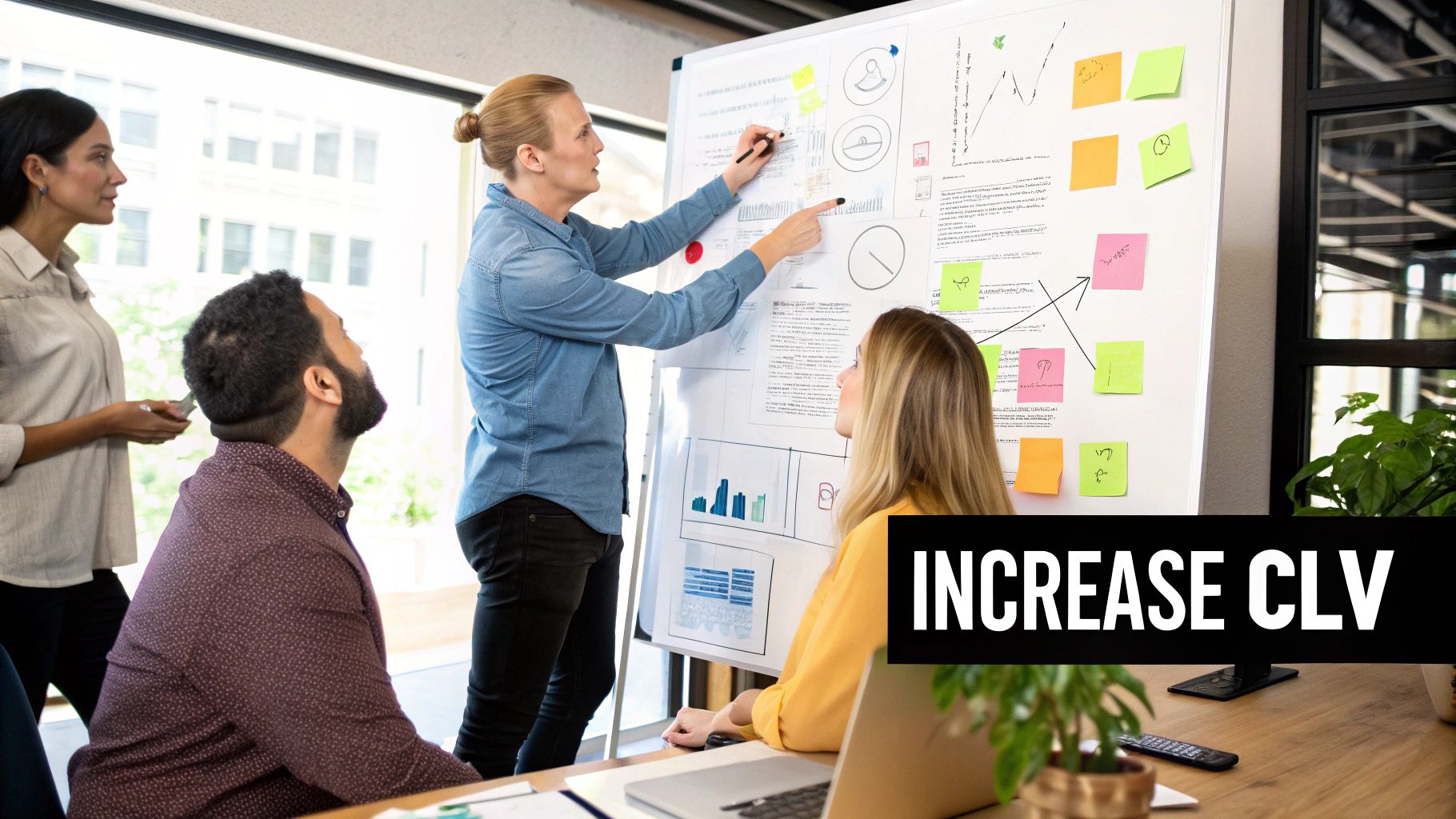
Treating all your customers the same is one of the fastest ways to waste your marketing budget. Once you have a handle on customer lifetime value, the real magic happens when you use that data to get smarter about how you communicate. This is where segmentation comes into play—it's how you personalize your marketing and drive sustainable growth.
From our work with over 500 Shopify stores, we've seen one strategy deliver results time and time again: grouping customers based on their CLV. It allows you to ditch the generic, one-size-fits-all messages and start conversations that genuinely connect with each group, which in turn boosts your ROI.
Your Three Core Customer Segments
A simple way to start is by thinking of your customer base in three distinct tiers. By splitting them up, you can tailor your WhatsApp marketing to give each group exactly what they need to hear.
- Your VIPs (High CLV): These are your brand champions. They buy frequently, spend more, and are the bedrock of your business. Your job isn't just to keep them happy, but to delight them so they become your most passionate advocates.
- Your 'At-Risk' Customers (Average CLV): This is where your biggest growth potential lies. They've purchased more than once but haven't hit that "loyal" status yet. A little nudge could turn them into a VIP, but ignoring them could mean they drift away for good.
- Your Newcomers (Low CLV, High Potential): These are your fresh, first-time buyers. Their CLV is low simply because they're at the very beginning of their journey with you. The primary goal here is to deliver an amazing post-purchase experience that encourages that critical second sale.
Tailored WhatsApp Strategies for Each Segment
A common pitfall we see brands fall into is pouring all their resources into acquiring new customers while forgetting that different existing customers have different needs. Here’s a practical look at how you can use Kanal to get the right message to the right person.
Nurturing Your VIPs
Your best customers don't need another generic 10% off coupon. What they really want is recognition and a sense of exclusivity. Making them feel like true insiders is a far more powerful retention tool than any discount.
The strategy that consistently delivers for our top clients is treating their VIPs less like customers and more like an exclusive club. This deepens loyalty in a way that discounts never can.
For this top-tier group, you can use Kanal to send highly personal messages that reinforce their status:
- Early Access: "Hi [Name], as one of our VIPs, you're getting first access to our new collection before anyone else. Here's your exclusive link to shop now: [Link]"
- A Personal Thank You: A simple, non-automated message from the founder can work wonders. "Hey [Name], I just wanted to personally thank you for being one of our best customers. We truly appreciate your support."
These small gestures do more than just make someone feel good; they become a foundational part of your brand's unique customer loyalty program ideas.
Re-Engaging At-Risk Customers
This middle segment needs a more proactive touch to keep them from falling off. A well-timed, targeted win-back campaign can be incredibly effective here. For example, you could set up a flow in Kanal that automatically triggers if a customer in this group hasn't made a purchase in 90 days.
- The Gentle Nudge: "Hey [Name], we miss you! It's been a while since we last saw you. Here’s a special 20% off to welcome you back: [Link]"
This message accomplishes two things: it shows you've noticed they've been gone and gives them a compelling reason to come back. It's a straightforward way to bridge the gap and start nudging their CLV upwards.
Answering Your Top CLV Questions
https://www.youtube.com/embed/eHi875QuVcA
We've walked through the nuts and bolts of how to calculate customer lifetime value and put it to work for your brand. But after working with countless e-commerce owners, I know there are always a few lingering questions that pop up. Let's tackle them head-on so you can feel confident putting this all into practice.
How Often Should I Calculate CLV?
This is a fantastic question and one we get all the time. My advice? Calculate your CLV on a quarterly basis.
Doing it quarterly strikes the perfect balance. It’s frequent enough to give you a real pulse on your marketing's impact and catch meaningful trends. At the same time, it’s not so frequent that you’re chasing your tail over minor, day-to-day blips in the data.
Think about it this way: if you push a huge WhatsApp campaign for Black Friday in the fourth quarter, a Q1 review will show you exactly how that effort moved the needle on purchase frequency and average order value for those customers. The return on your investment becomes undeniable.
What Is a Good Customer Lifetime Value?
This is the million-dollar question, isn't it? The honest answer is, it really depends on your industry and specific business model.
A store selling high-end furniture is going to have a completely different CLV than a direct-to-consumer coffee subscription brand. It's apples and oranges. Instead of fixating on some universal magic number, the most important metric to watch is your Customer Acquisition Cost (CAC).
The rule of thumb we always share with clients is to aim for a CLV-to-CAC ratio of at least 3:1. For every dollar you spend bringing in a new customer, you should be making at least three dollars back over their lifetime with you.
From our experience working with over 500 Shopify stores, brands that consistently hit that 3:1 ratio have built a truly healthy and sustainable engine for growth.
My CLV Is Low. What Are the First Steps to Improve It?
If your CLV isn't where you want it to be, don't panic. It's a common hurdle and absolutely fixable. The single most powerful place to start making improvements is your post-purchase experience. This is your golden moment to transform a first-time buyer into a repeat customer.
Here's a simple, actionable first step you can take right now using a tool like Kanal for WhatsApp:
- Send a warm thank you message the moment an order is delivered.
- A few days later, check in and ask for feedback on their purchase.
- About a week after that, send a useful tip on how they can get the most out of their new product.
This isn't just about sending messages; it's about showing you care long after the credit card is swiped. It’s one of the most powerful customer retention techniques you can use because it builds a genuine relationship and drastically increases the chances of getting that all-important second purchase—the biggest lever you can pull to boost your CLV.
Ready to start building these high-converting flows and boost your own CLV? Get a demo of Kanal at getkanal.com/demo and see how we can help.

